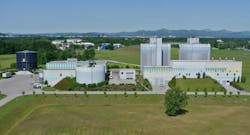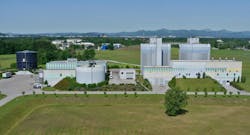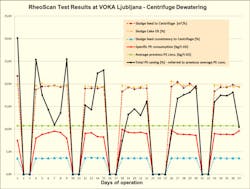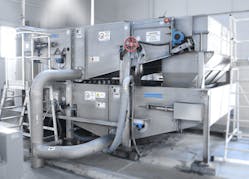Polymer consumption contributes significantly to wastewater treatment plant operating costs. Due to the unpredictability of sludge treatment, several attempts have been unsuccessful in developing a control system to improve efficiencies in this area. Yet a new optical detection system has been tested in Ljublana, Slovenia.
By Vesna Mislej and Joseph Haintz
It is widely known that a lower polymer dosage enhances biogas production because the polymer surrounding the biomass hinders the action of the bacteria in the degradation process.
Several attempts have been made by various companies to develop a control system for optimisation of polymer dosing and simply failed because these systems were not user-friendly, not reliable and did not show long-term savings. In fact, they failed due to the unpredictable changes in the sludge qualities, colors, reflection behavior of sludge surfaces, or fouling of sensors in contact with sludge or filtrate.
For the optical detection system developed by ANDRITZ, called the RheoScan system, the same principle was used that an experienced operator would apply by optimising the operating conditions after observing the sludge distribution and flocculation quality and adjusting them in order to avoid flooding the gravity section.
The RheoScan’s camera view of the belt edges monitors the flow pattern and adjusts the polymer dosage to make sure that there is always a minimum strip left free at the side of the belt to prevent flooding.
The technology uses the flow characteristics of flocculated sludge, which changes significantly when the polymer dosage is varied. This behavior can be observed easily on a belt thickener or in the gravity zone of a belt press. A camera scans the sides of the belt continuously in the gravity dewatering zone in the area where the sludge surface is almost stable and not free-flowing.
Based on a pre-set flocculation status, the control system now always regulates the polymer added in such a way that this free area at the sides remains constant. If the free area becomes smaller, more polymer is added in order to obtain a thicker sludge that remains within the pre-set limits and does not flow over the edges of the belt.
On the other hand, a large free area indicates excessive polymer dosing, hence the RheoScan control system reduces the amount of polymer added until the pre-defined free area settings are restored.
Test installation, Ljubljana
A test installation was carried out at public company JP Vodovod -Kanalizacija d.o.o. (VO-KA), which is legally responsible for the collection and treatment of domestic wastewater and also rainwater in the municipality of Ljubljana, Slovenia and in the six municipalities surrounding it.
The test goal was to show what improvements can be achieved overall, from thickening to digestion and on to the subsequent dewatering process, by reducing polymer dosage on the belt thickener.
The test with the RheoScan started in 2015 with the aim of clarifying these aspects, and the following targets were set, to be evaluated at the end of the test phase:
- Optimise/reduce polymer consumption at the belt thickener by achieving minimum thickening of >5% dry solids
- Check impact of reduced PE dosage on digester performance - mainly with respect to biogas production
- Check impact of reduced PE dosage for thickening on PE consumption in the centrifuge dewatering system
- Demonstrate reliable operation of the RheoScan system in the long term
In order to allow comprehensive data evaluation right away in the test phase, ANDRITZ used the new SMART Service software tool, which provided immediate evaluation of online process data together with laboratory data. With this tool, it was also possible to calculate the total mass flow in dry solids and record the exact time of RheoScan activation and the specific values, such as the polymer consumption in kg PE/t DS for every set of online signals from the thickener as well as from the centrifuges.
In addition, performance data from operation without control by the RheoScan system could be compared directly with subsequent operating periods when the RheoScan system was used so the differences became visible immediately.
Data transfer from VOKA’s SCADA system to the RheoScan control switchboard was installed for the following signals from the belt thickener process:
- RheoScan - On/Off
- Polymer flow - actual value
- Polymer flow - control signal to VFD drive of polymer pump
- Dry solids content of sludge feed to belt thickener - online measurement signals
- Dry solids content of sludge discharge from belt thickener - online measurement signals
- Belt speed.
The test period evaluated for RheoScan control was from June 1 to July 17, 2015. Data collection was performed until the end of September 2015 in order to check and compare operating conditions and performance for longer periods and even after RheoScan had been dismantled.
Digestion process
It is known in theory and from practice that polymer addition is counterproductive for the digestion process because it hinders degradation of the biomass in the digester. The target for the tests now was to quantify the increase in biogas production which may have resulted from the reduced polymer dosage in the thickening process as a result of using the RheoScan control system.
In order to compare the data from the digesters properly, the biogas release time had to be considered. It is known from a study performed by the National Institute of Chemistry’s Laboratory for Environmental Sciences and Engineering, performed in 2012 with sludge samples from the Ljubljana WWTP, that more than 90% of the biogas is released within the first seven days in the digester, more than 95% is released after the first 10 days, and that biogas production (100%) is finally complete after 18 days.
The specific gas production trend was calculated as an alternative for seven, 10, and 15 days delay in biogas release in order to see whether there is any difference in the gas production increase. In fact, the minimum overall increase found over the test period was 11.7%.
From these trends, it can be assumed that using the RheoScan at the belt thickener does result in a significant reduction in polymer dosage at the centrifuge as well. This can be explained by the more efficient flocculation achieved prior to centrifuge dewatering because there are fewer weak binding forces remaining after pre-flocculation at the belt thickener.
In this respect, it is important to point out that neither the cake dryness nor the throughput deteriorated during this period when less polymer was added.
Lessons Learned
Test operation at the Ljubljana WWTP as well as other sites showed that, with some additional features, the RheoScan can be used to achieve fully automated belt thickener operation.
In addition to the normal control feature for polymer dosing, the functionality - automatic start and stop of RheoScan control system - should be implemented.
This is important to avoid excess polymer dosing in cases where the sludge is heavily diluted, which may happen under start conditions. As a result, the concentration must be measured at the sludge feed and a signal sent to the RheoScan in order to set a minimum concentration limit to initiate start and stop of the RheoScan control system.
Controlling the thickened sludge discharge concentration.
This makes it possible to optimise the operating range for thickening and only requires another sludge concentration measurement to be made at the thickener discharge.
The minimum thickening required can be defined so that the RheoScan reduces PE dosing under adverse conditions to the extent that the dry solids content only drops to a minimum preset limit. RheoScan then increases the polymer dosage automatically until thickening returns to the normal range. After this, the RheoScan system resumes its optimization function.
Automatic belt control:
Test experience showed that the normal belt speed setting on a belt thickener is usually too high for optimum dewatering efficiency, but is used because it is more likely to prevent the sludge from flowing over the edges of the belt. The negative side is that sludge retention time on the belt is lower and hence, the thickening result is not as good as that achieved with lower belt speed.
With optical scanning of the side sections of the belt by the RheoScan camera, there is continuous automatic control to adjust polymer dosing accordingly and prevent the sludge from flowing over at the edges. As a result, the belt speed can be reduced considerably compared to normal, manual operation.
With these additional control features for the RheoScan, manual intervention at the belt thickener is limited to pushing the start/stop button and adjusting the sludge flow to be processed. It should be noted that online concentration measurement system in operation at the Ljubljana WWTP for many years was found to be very reliable and accurate.
Economic considerations
The savings achieved by reducing the polymer dosage at the belt thickener and the centrifuge, together with the increase in biogas production do provide a very interesting return on investment for installation of a RheoScan system.
In fact, the savings calculated over a one year period reveal that the investment for the RheoScan system is amortized within only a few months as a result of the polymer saving and increase in biogas production.
This ROI calculation does not consider further advantages from:
- Personnel cost savings due to automatic thickener control
- Higher operating availability
- Less wear due to lower belt speed at thickener
- Remote viewing of thickener from the control room with the RheoScan camera.
As the RheoScan can be accessed via WLAN, there is also the advantage of ANDRITZ being able to perform remote services via a direct connection to the actual performance data as well as obtaining pictures during operation, including historical data. This provides additional benefits for the customer, such as:
- Remote access for software upgrades
- Remote process data evaluation and troubleshooting by ANDRITZ.
Overall, the tests have demonstrated that this new polymer optimisation system enables significant polymer savings as well as fully automatic operation of a belt thickener or belt press at a reasonable investment level. If there is a subsequent digestion and dewatering process in place, the savings to be assumed there provide an outstandingly short amortization period in the region of just a few months.
Vesna Mislej is from Vodovod Kanalizacija in Slovenia and Josef Haintz is from Andritz AG, Austria.
More Water & WasteWater International Archives Issue Articles





